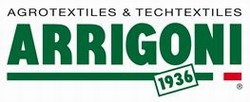The use of textile protective screens in agriculture entails advantages at least in terms of:
- increase in the yield of cultivated land by multiplying cycles per season and protecting from atmospheric agents
- reduction of pesticide use, with equal protection against the most aggressive insects for each individual crop
- improvement of the microclimate, through the control of ventilation, temperature and air quality as well as through the mitigation of the direct impact of rain on the foliage and on the fruits and the proliferation of bacteria and fungi
- optimization of plant irradiation conditions to achieve the right amount and quality of light (intensity, diffusion and color).
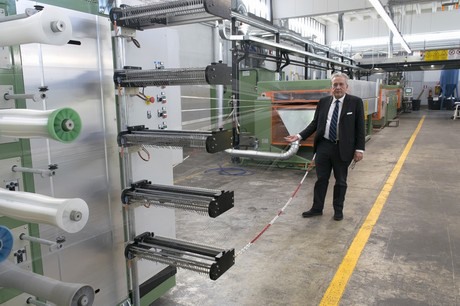
Arrigoni agrotextiles are made from high density polyethylene, whose production is optimized to guarantee long life (ten years) at the most severe atmospheric conditions.
This last characteristic is decisive for ensuring the absence of a direct environmental impact linked to the use of nettings in agriculture. Although agrotextiles are made of plastic material (polyethylene), their characteristics and the advanced manufacturing system allow that their application in the field nullifies (and actually exceeds) the carbon footprint linked to its manufacture. Unlike what could be expected, Arrigoni agrotextiles reveals that their use brings advantages to the environment.
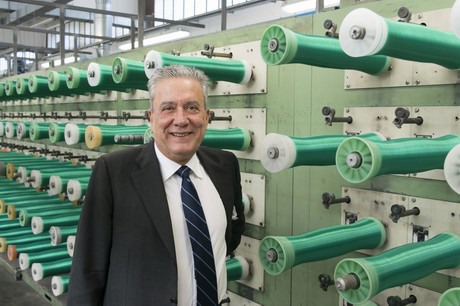
It is well known that the so-called "climate-changing gases" or "greenhouse gases" among which the most widespread is carbon dioxide (CO2) are those that generate the rise in temperature of the planet Earth. They are produced by almost all human activities and are particularly present in the combustion of hydrocarbons, which occurs in any "traditional" process of electricity production. Using specific calculation models and data surveys, it is possible to calculate the CO2 produced by each industrial process (at least because it consumes electricity or directly produced from the combustion of hydrocarbons).
This video provides interesting information about Earth’s temperature raising related to the increase in population along our recent history.
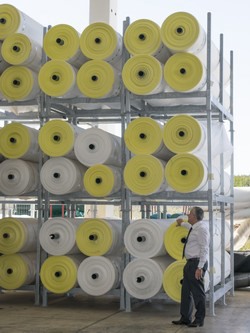 Positive environmental impact of Arrigoni agrotextiles can be understood, for example, following the fate of 100 grams of an open field agrotextiles. On average it covers and therefore protects 1.5 m² of land, allowing plants to grow undisturbed.
Positive environmental impact of Arrigoni agrotextiles can be understood, for example, following the fate of 100 grams of an open field agrotextiles. On average it covers and therefore protects 1.5 m² of land, allowing plants to grow undisturbed.
Let’s evaluate 5 different and widespread horticultural crops from Tables 1 and 2 below. Since agrotextile protection allows to develop higher yields due to the greater number of crop cycles, it can be observed that 100 grams of agrotextile allow an average of 105.8 kg of vegetables to be grown in ten years.

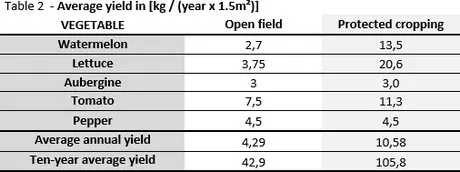
Then:
- The production of 100 grams of agrotextiles generates about 0.3 kg CO2eq (see the specific study contained in the article M. Dassisti, F. Intini, M. Chimienti, G. Starace – Thermography-enhanced LCA (Life Cycle Assessment) for manufacturing sustainability assessment. The case study of an HDPE (High Density Polyethylene) net company in Italy, (2016) Energy; Elsevier - vol.108, pag. 7-18 - doi: 10.1016/j.energy.2016.01.043)
- During 10 years of its life cycle, agrotextiles will allow the growth of about 105.8 kg / 1.5 m² of vegetables
- for vegetables, on average:
- carbon content is 50% of their dry weight
- dry matter weight in vegetables is only 10% of the gross weight (due to the presence of 90% of water)
- for every gram of dry matter, half a gram is carbon which is equivalent to 1.83 g CO2 or 0.00183 kg CO2 removed from the atmosphere in the chlorophyll photosynthesis process.
It is possible to estimate CO2 consumption of 1.5 m² of protected cultivation during the 10 years agrotextile average life through the expression below:

This result should be read in the sense that 100 grams of Arrigoni agrotextiles – covering an average of 1.5m² of vegetable cultivation – allow the protected crop to absorb 19.41 during the 10 years agrotextile life, against an emission of 0.3 kg CO2eq.
There is then a net advantage for the environment, which consists in the removal of 19.11 for every 100 grams of Arrigoni agrotextile produced and used.
Unlike what would be easy to think, this result reveals that plastic materials of Arrigoni agrotextiles do not pollute, but contribute to reducing the carbon footprint of human activity on planet Earth.
To this evidence on the direct environmental effects of agrotextiles, different positive elements must be added. Here a list – certainly lacking – that tips the balance to the choice of agrotextiles:
- recyclability: polyethylene of the protective screens is recyclable. Collection systems are already widespread in some more sensitive countries. This make it convenient to deliver waste products to allow safe and clean recovery and recycling;
- support for population growth: the guarantee of the most abundant and guaranteed quality and quantity of crops, as occurs with the use of agrotextiles, is a necessary condition to counter the increase in the nutrition needs of a growing population, particularly in developing countries in which it is more difficult to cultivate the earth;
- food democracy: the possibility of controlling the microclimatic conditions of crops widens the territories in which it is possible to cultivate, allowing them to procure nutritious food for those who are lacking of them ordinarily;
- meat production: the use of screens also for the purpose of protecting livestock, with the control of the climate of the places lived by the animals raised, increases their production and consequently expands the possibilities of feeding the entire planet population.
Arrigoni Advanced Agrotextiles are, then, long-term solution (up to 15 years in favorable conditions) for a "noble" purpose = to feed the planet in an ethical and sustainable way.
